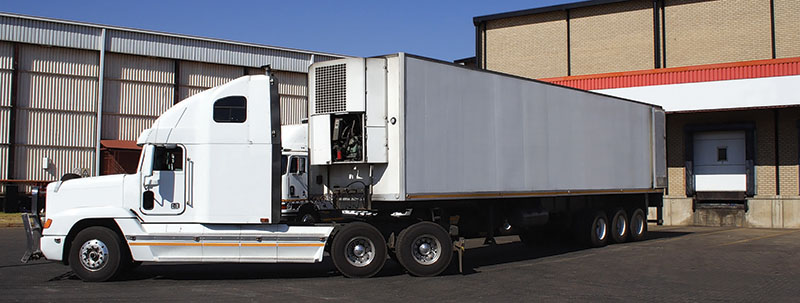Cold Chain 2021: Under pressure
While most of the focus on cold chain logistics has been primarily on pharmaceuticals and medical goods during the pandemic, the food logistics industry is now under increasing scrutiny and enormous pressure to improve performance.
The COVID-19 pandemic has changed the way food industry shippers and third-party logistics (3PL) providers connect with last-mile transportation providers, notes the Customized Logistics & Delivery Association (CLDA). According to spokesmen, many shippers and 3PLs have formed new strategic partnerships in the face of these changes to combat same-day delivery expectations fueled by the “Amazon effect” during lock-down.
This was also the conclusion contained in a new whitepaper jointly produced with the Transport Intermediaries Association (TIA) titled “The Age of Amazon: Why 3PLs & Last Mile Delivery Fleets Must Draw Closer.”( See Sidebar.) “Final-mile logistics is an important relationship for our members and is a multi-billion-dollar industry that plays an integral role in the supply-chain,” says Anne Reinke, president and CEO of TIA.
Steve Howard, president of CLDA, further explains how the two associations need to pinpoint trends where 3PLs and last-mile delivery providers can join together to compete against Amazon’s market dominance. “The last-mile sector has growing opportunities for 3PLs to broaden their menu of supply chain services by creating partnerships with local fleets operated our members,” he adds.
On the front lines
In a series of interviews with CLDA shippers, we discover the many challenges continuing to confront today’s food logistics practitioners.
For Mitchell Newman, president of Mitchell’s NY Logistics in New York City, the demand cycle for serving homes in the metropolitan district has been intense. And as his customers “re-invented themselves,” he also had to find a way to innovate.
“The restaurants we serve pivoted to home delivery for their customers who could no longer enjoy these high end menus,” Newman explains. This 75-year-old, family-run, full-service logistics company has three New York City warehouses and 12 refrigerated frozen trucks and vans as well as 14 dry trucks.
“We used our fleet of refrigerated Sprinters to deliver everything from gourmet $50 plate meals, including the alcoholic beverage of choice, to a smoothie bar that needed to get a healthy morning boost to their loyal customer following,” says Newman.
Kelly Picard, CEO of Hackbarth Delivery Services in Mobile, Ala., agrees with Newman’s assessment, though allows that states like his that were quicker to “open up” may have given logistics managers an advantage. “People need community and interpersonal interaction,” he says, “and peak season came much earlier last year, thereby expanding the definition of ‘essential’ workers. Prior to the pandemic, grocery store clerks were not viewed as being key to the food logistics supply chain—now we know they are.”
To accommodate changes in the cold chain, Picard says that stores have had to alter their configurations, forcing employees to pick orders and expedite the delivery. This has created a need to find delivery drivers with the expertise to maintain temperature for products requiring refrigeration. “In addition to that, grocery stores had to increase employees to be able to keep shelves stocked and pull orders,” he says.
Meanwhile, consumer behavior hastened the trend towards curbside pickup. “Certain Sam’s Clubs and Targets have moved customer service desk locations or café locations to a different spot in the store,” says Picard. “And as people have become comfortable with this service, it does not appear to be shrinking back to pre-pandemic levels.”
Founded in 1975 with a single truck, Hackbarth has grown into a leading logistics provider in the Southeast, covering 11 states with 40 terminals and cross-docks and delivering over 200,000 packages each day. Concurrent with that growth, says Picard, is more reliance on strategic partnerships.
“Most regional carriers have seen a spike in volume of residential deliveries during the pandemic, and that has continued even as the country has opened up,” says Picard. “This trend has also allowed shippers to compete better with Amazon.”

Picard adds that it appears that Walmart has “come to the party and is doing a great job” on delivery time for online orders. “Amazon has started to fall behind on their ‘Prime Delivery’ model, exceeding the 2-day expectation that they created for consumers in the world of free delivery,” he says. “We recently conducted a study of on-line order delivery time and found that Walmart met and often exceeded their promised delivery time on most orders.”
Joel Pinsky, CFO of Global Messenger and Logistics, observes that the restaurant and food-related industries are recovering slowly in Florida and the Mid-Atlantic states in their service network. “Refrigerated transportation of food to restaurants, festivals and other special events was completely shut down for various periods of time for our company,” he says. “Closures varied by state, making it extremely hard for anyone to plan.”
Last-mile is a team effort
The whitepaper, “The Age of Amazon: Why 3PLs and Last-Mile Delivery Fleets Must Draw Closer,” points to four areas where cold chain shippers and 3PLs can and have worked together to meet the increasing demands of consumers:
E-commerce: With people spending more time at home during the pandemic, online sales increased by 44% in 2020 to reach 21.3% of total retail sales. Delivery of heavy goods purchased through e-commerce channels is an area of opportunity the whitepaper cites for fleets that can meet specialized delivery requirements such as setup and reverse logistics for items such as medical devices, exercise and home office equipment.
Medical lab logistics: Laboratory tests for blood and tissue samples are conducted 13 billion times a year in the United States and have time-sensitive and specialized handling and delivery requirements. Last-mile providers have seen their medical business increase significantly during the COVID-19 pandemic, including work transporting vaccines with hospital networks.
B2B: Freight opportunities in the B2B last-mile sector abound for pallet-sized LTL freight and heavier items that have unique service requirements such as after-hour deliveries to business and residential customers. These are best met by a combination of 3PL and last-mile providers. Motor carriers and 3PLs are chasing opportunities in the last-mile of this sector to offer blended warehousing and delivery services that smooth order fulfillment for customers that experienced supply chain disruptions from COVID-19.
Special projects: Last-mile fleets that operate facilities near large urban centers, like New York City, are seeing demand increase from shippers, 3PLs and motor carriers to utilize their local cold chain delivery services. These customers are dropping off large-volume truckload and LTL shipments at their docks. Last-mile carriers separate volume loads into smaller shipments and make urban deliveries on repeat schedules, such as distributing shipments to retail stores.
Furthermore, says Pinsky, drivers were out of work or in limited demand, and office workers were either not permitted or afraid to work in an office setting. “At the start of the pandemic, we decided that it would be productive for us to focus on vaccine delivery,” he says.
The major problem with this idea was the information gap between regulators and government authorities in charge of “Operation Warp Speed.” Pinsky maintains that the leadership in cold chain logistics was badly wanting. “Shippers have learned that the most basic business strategies are now more important than ever,” he says. “Cash flow is critical in order for any of them to survive. Communication at and between all levels of business is now also a major focus.”
Customizing imperatives
Moving a food shipment across the cold chain without suffering any setbacks or temperature anomalies requires the establishment of a comprehensive logistical process to maintain the shipment integrity, our experts concur.
Factors such as duration of transit, the size of the shipment, and the temperatures experienced are important in deciding what type of packaging is required as well as the related level of energy consumption. It’s also vital for food shippers to first assess the products’ characteristics and prepare the shipment for the desired temperature.
Cold chain devices are commonly designed to keep the temperature constant, but not to bring a shipment to a specific temperature, so they would be unable to perform adequately if a shipment is not prepared and conditioned.
Furthermore, key considerations should be made for important processes, such as the final transfer of the shipment into cold storage facilities, as there is a high potential for a breach of integrity and damages to fragile goods such as produce.
Custom procedures may also prove to be a challenge, as cold chain products tend to be time-sensitive and are more likely to be subjected to inspection than regular freight. However, the current elephant in the room, says Hackbarth’s Picard, is rising costs.
“There is no such thing as a ‘free delivery’ or a ‘free return,’” says Picard. “In fact, returns are quite costly in the reverse logistics space. With the current shortage of truck drivers, coupled with the increased demand, spot rates in the trucking market have hit all-time highs in the last year multiple times.”

Article Topics
Motor Freight News & Resources
LM Podcast Series: Assessing the freight transportation and logistics markets with Tom Nightingale, AFS Logistics XPO opens up three new services acquired through auction of Yellow’s properties and assets FTR’s Trucking Conditions Index weakens, due to fuel price gains TD Cowen/AFS Freight presents mixed readings for parcel, LTL, and truckload revenues and rates Preliminary March North America Class 8 net orders see declines National diesel average heads down for first time in three weeks, reports EIA Trucking industry balks at new Biden administration rule on electric trucks: ‘Entirely unachievable’ More Motor FreightLatest in Logistics
LM Podcast Series: Assessing the freight transportation and logistics markets with Tom Nightingale, AFS Logistics Investor expectations continue to influence supply chain decision-making The Next Big Steps in Supply Chain Digitalization Warehouse/DC Automation & Technology: Time to gain a competitive advantage The Ultimate WMS Checklist: Find the Perfect Fit Under-21 driver pilot program a bust with fleets as FMCSA seeks changes Diesel back over $4 a gallon; Mideast tensions, other worries cited More LogisticsAbout the Author
Subscribe to Logistics Management Magazine

Find out what the world's most innovative companies are doing to improve productivity in their plants and distribution centers.
Start your FREE subscription today.
April 2023 Logistics Management

Latest Resources
















